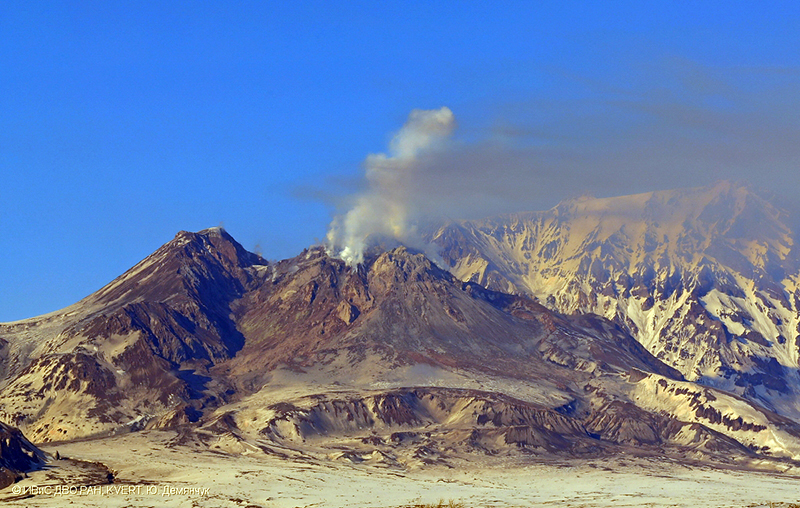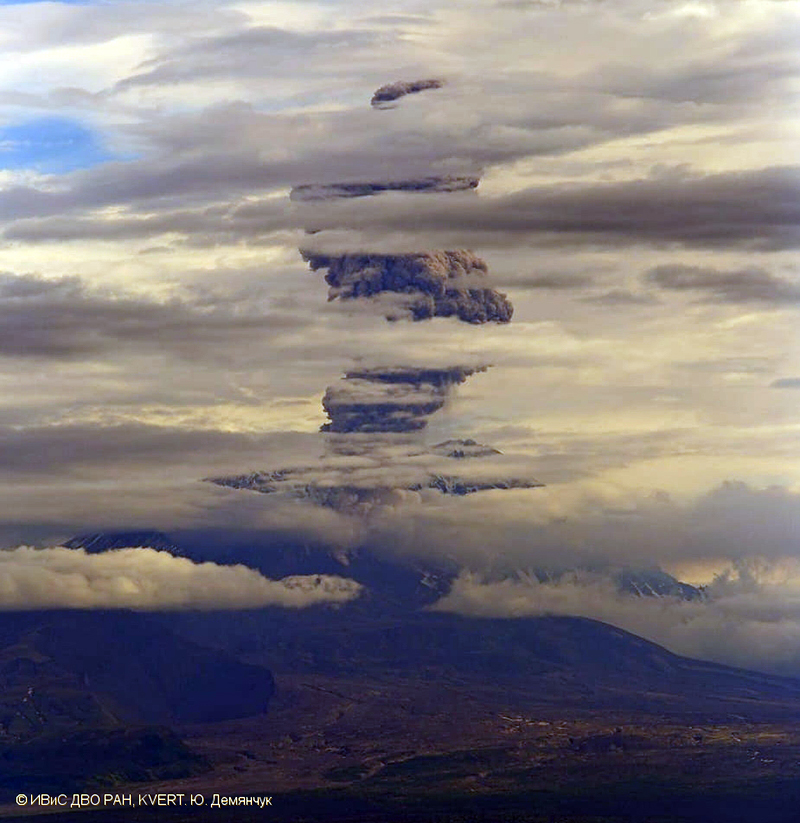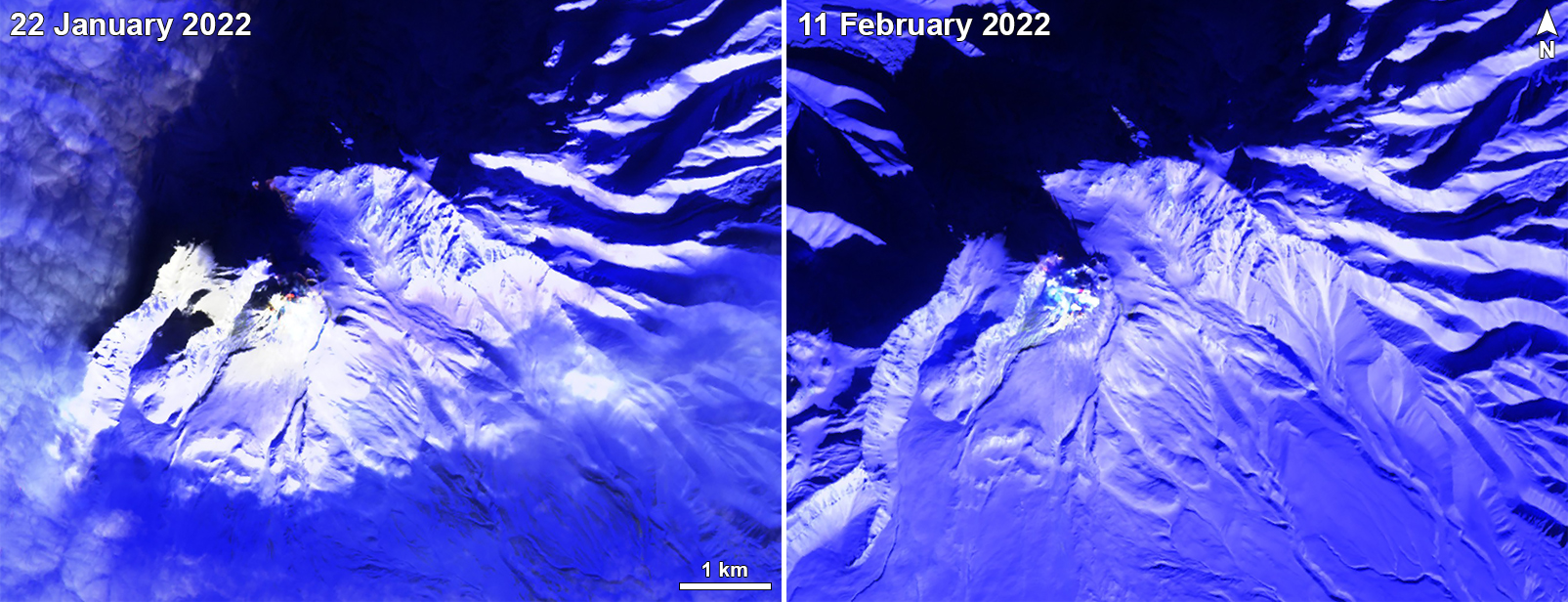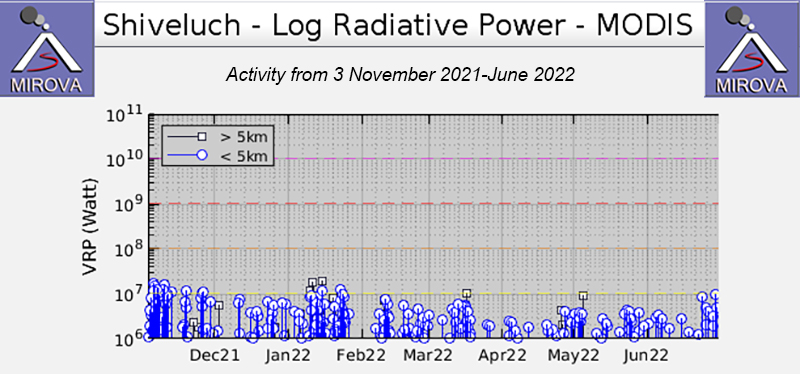Report on Sheveluch (Russia) — July 2022
Bulletin of the Global Volcanism Network, vol. 47, no. 7 (July 2022)
Managing Editor: Edward Venzke.
Edited by Kadie L. Bennis.
Sheveluch (Russia) Occasional explosions, ash plumes, and lava dome growth during January-June 2022
Please cite this report as:
Global Volcanism Program, 2022. Report on Sheveluch (Russia) (Bennis, K.L., and Venzke, E., eds.). Bulletin of the Global Volcanism Network, 47:7. Smithsonian Institution. https://doi.org/10.5479/si.GVP.BGVN202207-300270
Sheveluch
Russia
56.653°N, 161.36°E; summit elev. 3283 m
All times are local (unless otherwise noted)
Sheveluch, in the northeastern region of the Kamchatka peninsula, Russia, has produced at least 60 eruptions during the Holocene, with eruptions known from tephrochronology dating back 10,000 years. Frequent collapses of dome complexes have produced debris avalanches; the resulting deposits cover much of the caldera floor. A major south-flank collapse during a 1964 Plinian explosion produced a scarp within which a “Young Sheveluch” dome began to form in 1980. Repeated episodes of dome formation and destruction since then have produced major and minor ash plumes, pyroclastic flows, block-and-ash flows, and two “whaleback domes” of spine-like extrusions in 1993 and 2020 (BGVN 45:11). The current eruption period began in August 1999 and has more recently consisted of ongoing explosions, frequent ash emissions, incandescent block avalanches, and lava dome growth (BGVN 47:02). This report describes similar activity of intermittent explosions, ash plumes, continued lava dome growth, strong fumarolic activity, and block avalanches during January through June 2022 using information from the Kamchatka Volcanic Eruptions Response Team (KVERT), the Kamchatka Volcano Station (part of the Kamchatka Branch of the Geophysical Survey, Russian Academy of Science (KB GS RAS) and various satellite data.
Activity during this reporting period was relatively low. The growth of the lava dome inside the 1964 flank collapse scarp continued through June 2022 and on clear weather days, a small thermal anomaly was visible in satellite data (figure 85). Strong fumarolic activity with gas-and-steam emissions often accompanied this dome growth from multiple vents. Frequent low-level thermal activity persisted, though there was a gradual decline in power during January through April that remained low through June, as is shown in the MIROVA Log Radiative Power graph (figure 86).
The incandescent lava dome continued to grow during January 2022, in addition to observations of strong fumarolic activity and block avalanches. A thermal anomaly was visible over the dome daily. Satellite data showed a strong gas-and-steam plume containing some amount of ash on 7 January that rose to 4-4.5 km altitude and drifted as far as 24 km W. Explosions during 9-11 January generated gas-and-ash plumes to 3.5-5.5 km altitude and drifted 20-140 km WNW, 175 km W, and 80 km SW, respectively. Continued explosions were detected on 13 and 15-16 January, which produced ash plumes that rose to 5-6.5 km altitude and drifted 10-31 km NNW, W, and WSW.
Low activity persisted during February and March with strong fumaroles, block avalanches, and incandescence from the growing lava dome. A thermal anomaly was frequently visible over the lava dome on clear weather days. An ash cloud detected in satellite imagery on 15 March rose to 4.5 km altitude and drifted 50 km WNW. During April, lava dome growth continued, accompanied by strong fumarolic activity, block avalanches, and frequent thermal anomalies. Satellite data by KVERT on 9 April showed that explosions sent ash plumes to 12 km altitude and extended more than 2,000 km NE. Continued explosions during 14-17 April produced ash plumes that rose to 4-6.5 km altitude and drifted generally 4-45 km SW and SE.
During May and June, activity was relatively low and consisted of lava dome growth, strong fumarolic activity (figure 87), block avalanches, and incandescence. Thermal anomalies continued to be frequently detected in satellite data on clear weather days. According to video data, explosions on 10 June generated an ash plume that rose to 6.5 km altitude and extended 130 km SSE and E over the volcano. On 20 June at 0847 video data from KVERT showed an ash plume rose to 7 km altitude that extended 10 km E (figure 88). The next day on 21 June explosions produced an ash plume that rose to 5 km altitude and drifted 70 km SW.
 |
Figure 87. Photo of strong fumarolic activity at Sheveluch on 5 May 2022. Photo has been color corrected. Photo by Yu Demyanchuk, courtesy of IVS FEB RAS, KVERT. |
 |
Figure 88. A dense ash plume rose to 7 km altitude from Sheveluch on 20 June 2022 and drifted E. Photo has been color corrected. Photo by Yu Demyanchuk, courtesy of IVS FEB RAS, KVERT. |
Geological Summary. The high, isolated massif of Sheveluch volcano (also spelled Shiveluch) rises above the lowlands NNE of the Kliuchevskaya volcano group. The 1,300 km3 andesitic volcano is one of Kamchatka's largest and most active volcanic structures, with at least 60 large eruptions during the Holocene. The summit of roughly 65,000-year-old Stary Shiveluch is truncated by a broad 9-km-wide late-Pleistocene caldera breached to the south. Many lava domes occur on its outer flanks. The Molodoy Shiveluch lava dome complex was constructed during the Holocene within the large open caldera; Holocene lava dome extrusion also took place on the flanks of Stary Shiveluch. Widespread tephra layers from these eruptions have provided valuable time markers for dating volcanic events in Kamchatka. Frequent collapses of dome complexes, most recently in 1964, have produced debris avalanches whose deposits cover much of the floor of the breached caldera.
Information Contacts: Kamchatka Volcanic Eruptions Response Team (KVERT), Far Eastern Branch, Russian Academy of Sciences, 9 Piip Blvd., Petropavlovsk-Kamchatsky, 683006, Russia (URL: http://www.kscnet.ru/ivs/kvert/); MIROVA (Middle InfraRed Observation of Volcanic Activity), a collaborative project between the Universities of Turin and Florence (Italy) supported by the Centre for Volcanic Risk of the Italian Civil Protection Department (URL: http://www.mirovaweb.it/); Sentinel Hub Playground (URL: https://www.sentinel-hub.com/explore/sentinel-playground); Tokyo Volcanic Ash Advisory Center (VAAC), 1-3-4 Otemachi, Chiyoda-ku, Tokyo 100-8122, Japan (URL: http://ds.data.jma.go.jp/svd/vaac/data/).



